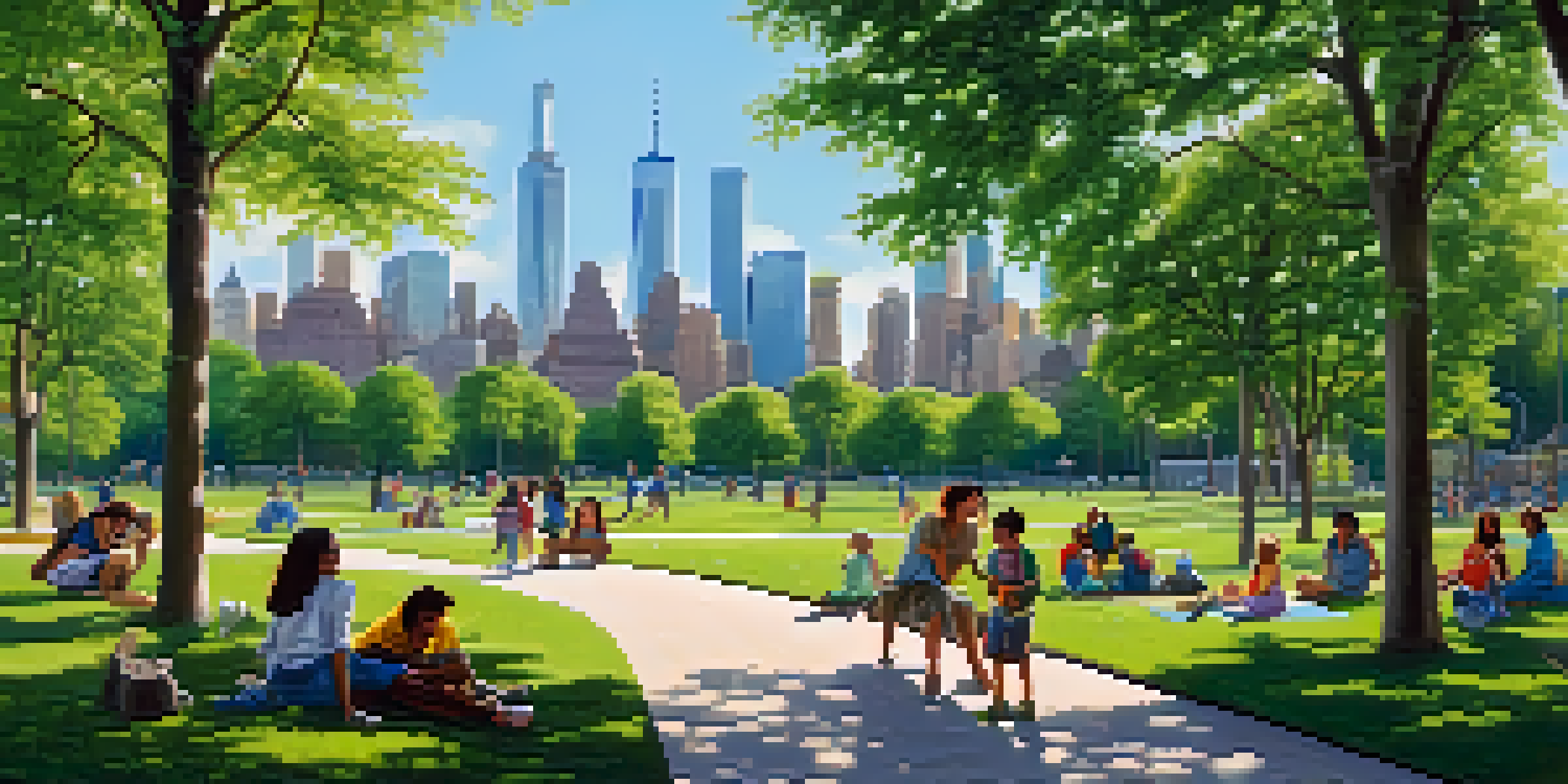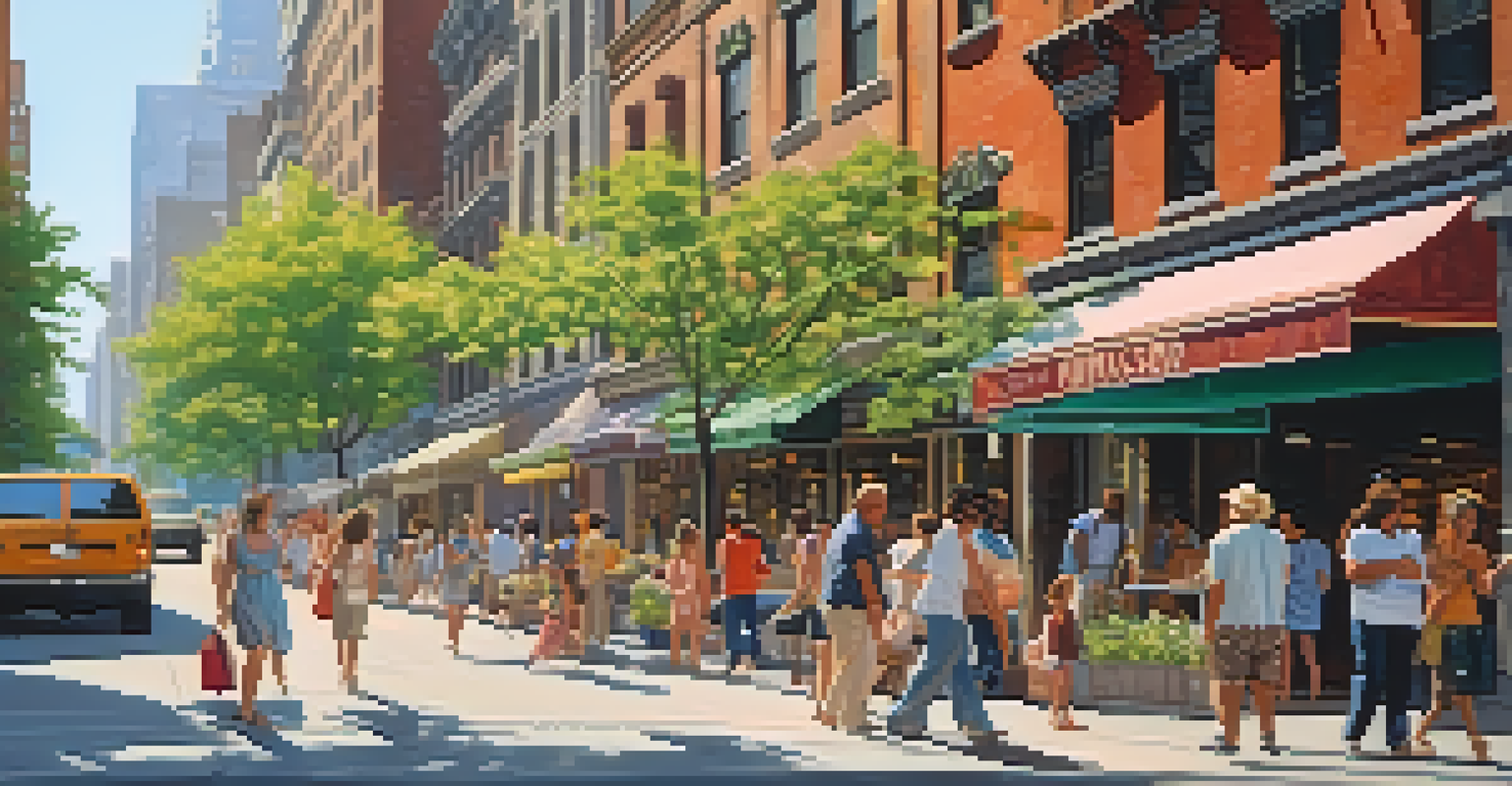Urban Heat Islands: Mitigating Effects in NYC's Developments

Understanding Urban Heat Islands and Their Impact
Urban Heat Islands (UHIs) refer to urban areas that experience significantly higher temperatures than their rural surroundings. This phenomenon primarily results from human activities and the materials used in city infrastructure, such as asphalt and concrete, which absorb and retain heat. In New York City, this heating effect can lead to increased energy consumption, elevated emissions of pollutants, and even health risks for residents, particularly during the sweltering summer months.
In the face of climate change, cities must integrate nature into their designs to create livable urban environments.
The impact of UHIs is not just about discomfort; it can exacerbate existing health disparities. Areas with fewer trees and green spaces tend to experience more intense heat, disproportionately affecting vulnerable populations, including the elderly and those with pre-existing health conditions. As a result, the need for effective mitigation strategies becomes increasingly urgent as climate change continues to intensify these effects.
Moreover, UHIs can strain the city's energy grid, leading to higher electricity demand for cooling systems during peak heat periods. This can result in higher utility bills for residents and businesses, as well as increased greenhouse gas emissions. To address these challenges, it is essential to explore innovative solutions that can help cool the urban landscape.
The Role of Green Infrastructure in Cooling Cities
Green infrastructure plays a vital role in mitigating the effects of Urban Heat Islands. By integrating natural elements such as trees, green roofs, and parks into urban design, cities can enhance their resilience to heat. For instance, trees provide shade and release moisture through a process called transpiration, which cools the air around them. This not only makes neighborhoods more comfortable but also improves air quality.

In New York City, initiatives like the MillionTreesNYC campaign have significantly increased tree coverage, contributing to a cooler urban environment. Furthermore, green roofs, which involve planting vegetation on rooftops, not only reduce heat absorption but also manage stormwater runoff and provide habitats for urban wildlife. These features create a more livable city while simultaneously addressing the UHI effect.
Urban Heat Islands Affect Health
Urban Heat Islands exacerbate health disparities, especially for vulnerable populations during extreme heat events.
However, the implementation of green infrastructure needs to be strategically planned, considering factors like location, species selection, and maintenance. Collaborating with landscape architects and urban planners can help ensure that these green spaces are effectively integrated into the existing urban fabric, maximizing their cooling benefits while enhancing aesthetic appeal.
Urban Planning Strategies to Combat Heat
Urban planning plays a crucial role in addressing Urban Heat Islands, as the design and layout of a city can significantly influence temperature variations. By promoting mixed-use development and creating walkable neighborhoods, cities can reduce reliance on vehicles, thus decreasing heat generated by traffic and emissions. Thoughtful zoning regulations can encourage the inclusion of green spaces and parks, which help to lower surface temperatures.
The city is not a concrete jungle, it is a human zoo.
Additionally, incorporating reflective materials and cool pavements in construction can create a more thermally balanced environment. These materials reflect rather than absorb sunlight, helping to keep urban surfaces cooler. For instance, using light-colored roofing materials and permeable pavement can effectively reduce the heat island effect while promoting sustainability.
Engaging communities in the planning process is also essential. When residents are involved in decision-making, they can advocate for green spaces and environmentally friendly practices that align with their needs. This collaborative approach not only enhances community buy-in but also fosters a sense of ownership over the urban environment.
Innovative Technologies Helping NYC Cool Down
In the fight against Urban Heat Islands, technology can serve as a powerful ally. Innovations such as smart weather stations and mobile apps can help residents stay informed about temperature changes in their neighborhoods. By providing real-time data, these tools empower communities to take proactive measures, such as planning outdoor activities during cooler parts of the day.
Moreover, advancements in building materials and designs are paving the way for more energy-efficient structures. For example, reflective and insulated windows can minimize heat absorption while maintaining comfortable indoor temperatures. As a result, not only do these technologies contribute to cooler urban spaces, but they also lower energy costs for residents and businesses.
Green Infrastructure Cools Cities
Implementing green infrastructure like trees and green roofs can significantly mitigate the effects of Urban Heat Islands.
Furthermore, cities can leverage satellite imagery and geographic information systems (GIS) to identify areas most affected by heat. This data-driven approach allows for targeted interventions, ensuring resources are allocated efficiently where they are needed most. By embracing technology, New York City can better adapt to the challenges posed by urban heat.
Community Engagement and Awareness Campaigns
Community engagement is key to successfully mitigating the effects of Urban Heat Islands. When residents understand the implications of UHIs and are educated about potential solutions, they are more likely to participate in initiatives aimed at cooling their neighborhoods. Awareness campaigns can include workshops, informational pamphlets, and social media outreach to share valuable insights and tips on how to contribute to cooling efforts.
For instance, organizing community planting days to increase tree coverage not only enhances urban greenery but also fosters community spirit. Residents can come together to plant trees, maintain gardens, or even install small green roofs on their homes, promoting a shared sense of responsibility for their environment. These collective actions can significantly reduce local temperatures while strengthening community bonds.
Additionally, local governments can partner with schools and organizations to create educational programs that emphasize the importance of green spaces and sustainable practices. By instilling these values in younger generations, cities can cultivate a culture of environmental stewardship that benefits future urban development.
Policy Initiatives Supporting UHI Mitigation
Effective policies are essential for addressing Urban Heat Islands on a citywide scale. Local governments can create regulations that mandate the inclusion of green infrastructure in new developments, incentivizing builders to adopt environmentally friendly practices. Programs that provide financial assistance for retrofitting existing buildings with green roofs or energy-efficient materials can further encourage compliance.
Furthermore, establishing heat action plans can help cities prepare for extreme heat events by outlining strategies for cooling, emergency response, and public health initiatives. These plans can prioritize vulnerable populations, ensuring that resources are allocated to those most at risk during heat waves. For example, opening cooling centers in low-income neighborhoods can provide relief to residents in need.
Community Engagement is Essential
Engaging communities in awareness and action initiatives fosters a collective responsibility for cooling urban environments.
Collaboration between public and private sectors is also crucial. By engaging businesses and non-profits in discussions about sustainable practices, cities can leverage additional resources and expertise to tackle UHI challenges more effectively. Policies that promote public-private partnerships can lead to innovative solutions that benefit both the urban environment and the economy.
Looking Ahead: A Cooler NYC for Future Generations
As New York City continues to grow, addressing Urban Heat Islands will be vital in ensuring a sustainable and livable environment for future generations. The ongoing commitment to integrating green infrastructure, embracing technology, and fostering community engagement will play a pivotal role in creating a cooler city. By prioritizing these initiatives, NYC can set an example for other urban areas grappling with similar challenges.
Moreover, as climate change intensifies, it is crucial for the city to remain adaptable and resilient. Regular assessments of UHI impacts and the effectiveness of implemented strategies will ensure that New York City can respond to changing conditions and continue to protect its residents. This proactive approach will be invaluable in navigating the complexities of urban living in a warming world.

Ultimately, building a cooler NYC requires collaboration among residents, city officials, and various stakeholders. By coming together and embracing innovative strategies, New York City can foster a healthier, more vibrant urban landscape that thrives for generations to come.